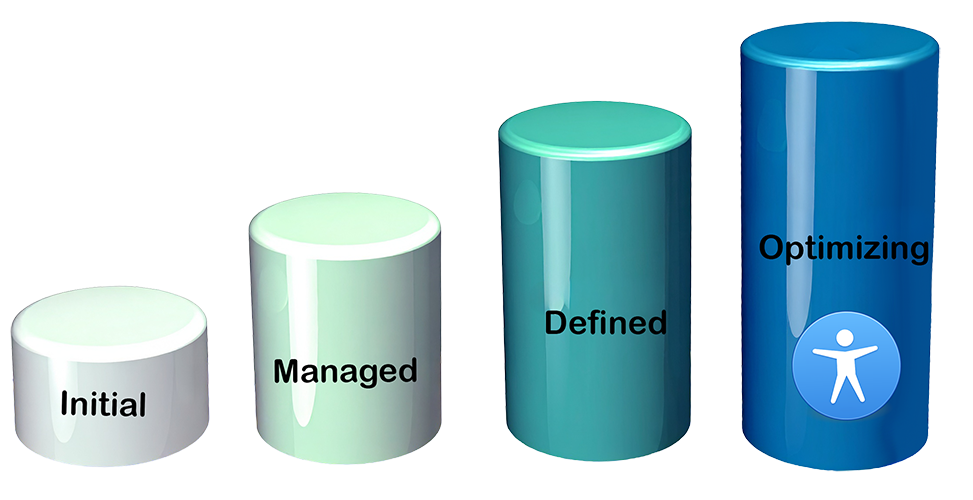Back in May of this year, I wrote a blog post about the importance of a sustainable, continuous accessibility monitoring strategy for ensuring long-term digital accessibility compliance and improvement.
This blog post is a follow-up, adding one more critical element to that strategy. That element is an Accessibility Maturity Model (AMM). I was also inspired to write this post when, about a month ago, the W3C Web Accessibility Initiative posted an invitation on LinkedIn to comment on their Accessibility Maturity Model.
What is an Accessibility Maturity Model?
Maturity models have been around since the 80s. They generally contain several levels of maturity. Each level includes a definition, controls, a list of processes, and proof points that an organization can use to claim they are at a particular level of maturity. An AMM looks beyond compliance and focuses on systemic adoption, meaning accessibility is built into everyday work rather than added on at the last minute, a shift-left approach.
Accessibility conformance testing provides information about a product's WCAG conformance level at a specific point in time. Accessibility maturity modeling, on the other hand, provides information about an organization's ability to produce said accessible product.
Elements of an AMM
While maturity models can differ, most are organized around several maturity levels and dimensions:
Maturity Levels
Maturity levels are a series of developmental stages that an organization progresses through. Again, not all models are the same.
| Maturity Level | Characteristics |
|---|---|
| Initial / Inactive | Accessibility is reactive. It is only addressed when a problem or lawsuit arises—or it’s simply nonexistent. There are no formal processes or policies. |
| Managed / Launch | Initial awareness and ad-hoc efforts begin. Basic accessibility policies are in place, and some testing is conducted. |
| Defined / Integrate | Accessibility is a defined process integrated into the development lifecycle, guided by a shift-left approach. Training is provided, and metrics are tracked. |
| Optimizing | Accessibility is a core value and a key driver of innovation. Processes are continually refined, and accessibility is proactively managed and automatically tested throughout the organization. |
Note: " Levels are cumulative, so level advancement is achieved by first meeting the specific criteria of a lower level." ~ Accessibility Maturity Model, W3C Group Draft Note 28 August 2025
Dimensions
Dimensions are the organizational areas or functions that are evaluated for their level of accessibility maturity. Some standard dimensions include:
- Culture
The organization's commitment, values, and leadership support for accessibility.
- Policy and Governance
Formal policies, standards, and the organizational structure managing accessibility efforts.
- Knowledge and Skills
The level of accessibility training, expertise, and resources available to staff and leadership.
- Information and Communication Technology (ICT) Development Lifecycle
Integrating accessibility into every phase of the product lifecycle.
- Procurement
Integrating accessibility requirements into the procurement process.
- Communications
Making both internal and external communications accessible.
Why Does My Organization Need an AMM?
An Accessibility Maturity Model helps your organization benchmark its current accessibility efforts, identify strengths and gaps, and prioritize areas for improvement. It also provides a framework for communicating progress to stakeholders and building a long-term, sustainable accessibility strategy.
An Accessibility Maturity Model will transform your organization’s accessibility efforts from a project to a process, and finally to a principle.
Resources
- W3C A11Y Maturity Model
- Accessibility maturity litmus test
- W3C Accessibility Maturity Model
- A Guide to Continuous Accessibility Monitoring
- What Is the Digital Accessibility Maturity Model?
- Comparison of the Different Accessibility Maturity Models
- Reviewing the Logic and Value of the W3C’s Accessibility Maturity Model
A human author creates the DubBlog posts. The AI tools Gemini and ChatGPT are sometimes used to brainstorm subject ideas, generate blog post outlines, and rephrase certain portions of the content. Our marketing team carefully reviews all final drafts for accuracy and authenticity. The opinions and perspectives expressed remain the sole responsibility of the human author.

